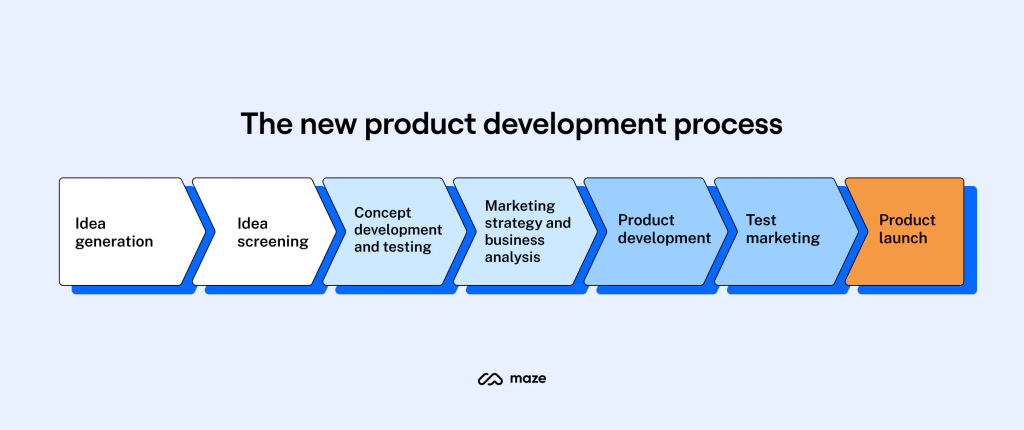Back to: User Interface (UI) Design Course
Product Development Lifecycle
Product development often involves cross-functional teams that work together to bring the product to market. These teams may include product managers, designers, engineers, marketers, and salespeople. Each team member brings unique skills and expertise to the table to ensure that the product is developed to meet customer needs and market demands.
The product development lifecycle is a framework that outlines the process of creating and bringing a product to market. In the context of user interface (UI) design, the product development lifecycle involves several stages, each with its own set of activities and goals.

The Product Development Lifecycle
The process of product development can vary from one digital product to another. However, most products will pass through a series of stages in their development process. These stages include:
Stage 1: Idea Generation, also known as the ideation stage, where the startup team will generate multiple ideas for new products based on multiple factors such as market research, user needs feedback, and concept testing. This stage aims to generate as many innovative ideas as possible.
- User Personas: What kind of user or customer are you looking to build a product for? Which problems might they encounter in their everyday life? Answering these questions will help you to build an ideal user persona.
- SWOT Analysis: Try evaluating the strengths, weaknesses, opportunities and threats of each idea. This is a quick way to flesh out each concept and allows for easy comparison between ideas.
- Existing Product Portfolio: Taking a critical look at your startup’s existing product portfolio could help spark ideas for new products. What do your current products do well? What could be improved? How could a new product complement this line-up?
Stage 2: Idea Screening and Refinement, where you evaluate the ideas generated in stage one and narrow down the pool to a few select choices. You should consider the more detailed elements of each idea, including cost and pricing, competition evaluation, and potential marketing strategy.
- Cost and Pricing: How much would each idea cost to develop? What might a pricing strategy look like for each product? It’s never too early to involve your financial team in the decision-making process.
- Competition Evaluation: Conducting an in-depth competitor analysis will help determine the potential product-market fit of each idea.
- Marketing Strategy: Mapping out a potential marketing strategy for a new product can help to pin down its Unique Selling Point. What sets your product apart from the rest?
Stage 3: MVP and Concept Validation, where you create a minimum viable product (MVP) as soon as possible, which is the earliest version of a product that is released with only the essential features necessary for a user to test it. It is important to test the product with users to gather feedback.
The aim of this stage is not to create a fully-fledged, finished version of the product. Concentrate your efforts instead on creating the most basic iteration of the product as quickly as possible, and release it immediately to start receiving user feedback.
For example, the web app Facebook started life as a bare-bones MVP in 2004. True to its name – ‘face – book’, the social media platform was first released as a simple web directory containing all the names and faces of students in a university.
Stage 4: Product Optimization, where you act on user testing feedback and optimize your product accordingly. This is an iterative process that involves collecting feedback on potential use scenarios, UX/UI design, and pricing strategy to increase the chances of achieving product-market fit.
Here are a few ideas of useful data points to collect:
- Potential Use Scenarios: Does this product solve any problems the user currently encounters in their life? In what kind of situation might they consider using the product?
- UX/UI Design: How easy is the product to navigate for a first-time user? Consider asking the user to try completing different tasks within the product, and then ask them to rate how easy or difficult they found the experience.
- Pricing Strategy: How much would the user be willing to pay for this product? Do they already pay for any other products that fulfill a similar purpose?
Stage 5: Product Launch, where you release the product to the market. You might release all features at the same time or benefit from a phased launch, which is a progressive rollout of a new product and its features to allow for continued iteration and fine-tuning of the product.
USE CASE:
Instagram Reels

When Instagram launched in 2010, the platform focused solely on image sharing between users. After the explosive success of the video-sharing platform TikTok a decade later, Instagram began to lose some of its competitive edge.
In response to the increased demand for video content by social media users, Instagram’s parent company, Meta, launched its ‘Reels’ feature in 2020. Users could now easily create, watch and share short-form video content in a dedicated new section of the app.
Despite the longevity and celebrated success of Instagram, it is still passing through the product lifecycle to this day. New and innovative features are still being tested, optimised and launched to ensure the web app remains competitive in a fast-moving market.